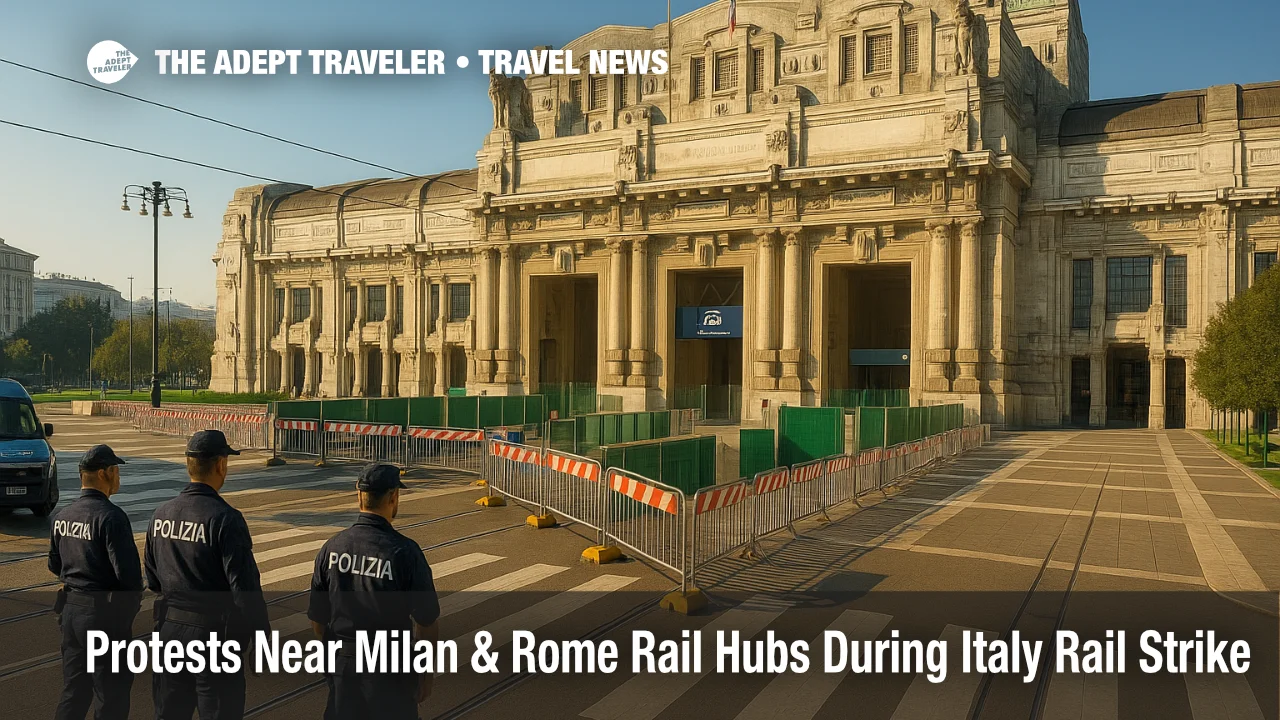Protest activity near Milan and Rome rail hubs during Italy rail strike

Travelers should expect police-managed protest activity around Milano Centrale and Roma Termini alongside the nationwide rail strike from 900 p.m. on October 2 to 859 p.m. on October 3. Authorities have intermittently funneled foot traffic and closed doors at peak hours after recent clashes near the stations. Build buffer time for station entry, use side entrances where available, and avoid curbside taxi queues during rallies.
Key points
- Why it matters: Crowding and cordons can delay access even when your train runs.
- Travel impact: Expect entry bottlenecks near commute windows and short-notice platform changes.
- What's next: Demonstrations are slated to continue into the weekend in Rome; plan around peak periods.
- Guaranteed trains run 600-900 a.m. and 600-900 p.m.; others face cuts.
- Malpensa and Fiumicino rail links may reduce service or switch to buses.
Snapshot
Italy's rail strike covers Trenitalia, Trenord, and parts of the FS network from the evening of October 2 through the evening of October 3, with legally mandated minimum service during the 600-900 a.m. and 600-900 p.m. windows. In Lombardy, trains departing by 900 p.m. on October 2 and arriving by 1000 p.m. may still operate. Separately, demonstrations near Milano Centrale and Roma Termini have prompted police to manage access, occasionally leading to rolling door closures and redirected flows. If you are connecting to or from Milan Malpensa Airport (MXP) or Rome-Fiumicino International Airport (FCO), verify airport-rail operations and consider licensed shuttles when crowds surge. Arrive early, carry digital tickets, and follow signed detours inside stations.
Background
Large demonstrations on September 22 escalated at Milano Centrale, where police blocked access points after groups pressed toward the station. Rome has announced heightened security for additional rallies centered on October 4, with authorities signaling crowd-control measures near transport interchanges. The U.S. Consulate in Milan warned of flash demonstrations that can form quickly around public venues and transit. While the strike targets rail operations, the practical constraint for many travelers will be getting into and through the stations during protest waves. That is why guaranteed windows can still feel congested even when trains run; entry screening, one-way pedestrian flows, and platform holds create chokepoints that ripple into missed connections.
Latest developments
Station access tips during Italy's rail strike and protests
Peak-hour protests around Milano Centrale and Roma Termini are most likely to affect travelers between roughly 700-1000 a.m. and 500-900 p.m. Enter early through less-used side doors when open, keep tickets visible for staff checks, and expect last-minute platform swaps. If the Malpensa Express or Leonardo Express reduces service, operators may stage nonstop buses; allow extra time and confirm pickup points away from rally areas. For broader strike mechanics and timing, see our earlier coverage of the nationwide stoppage, and for station-specific crowd advice, consult our protest advisory. Italy rail strike October 2-3 follows Friday's air-transport walkouts and Italy protest travel advisory at major rail hubs.
Analysis
The interplay of a 24-hour rail strike and protest-driven station controls concentrates demand into narrow windows. Guaranteed peak bands safeguard essential mobility, but they also pack concourses and stairs, which is where police cordons and one-way flows slow everyone down. At Milano Centrale, the open forecourt and multiple approaches invite march routes that can pinch curbside taxi ranks; travelers should shift pickups to rideshare zones or pre-book car services on cross streets. Roma Termini presents similar risks due to bus interchanges and Metro access; short Metro closures or mezzanine holds can cascade into missed Frecce departures minutes later. For airport connections, a conservative plan is best: aim for guaranteed-window departures, move critical segments earlier in the day, and keep a bus or coach option in your pocket. If you must travel outside the windows, expect rolling cancellations, longer security lines, and platform holds. In all cases, the simplest mitigations are early station arrival, side-entrance use, and avoiding taxi queues during rally peaks.
Final thoughts
Italy's rail strike is time-boxed, but protests near Milano Centrale and Roma Termini can briefly choke station access. Arrive early, take side entrances when open, and route around curbside queues to protect your itinerary during the Italy rail strike.
Sources
- Sciopero nazionale del trasporto ferroviario, October 2-3, RFI
- Trenord strike notice and guarantee windows
- Trenord Italian advisory with airport bus details
- Demonstration Alert: Flash demonstrations possible, U.S. Consulate General Milan, September 22, 2025
- Clashes at Milano Centrale during protests, RaiNews
- Roma security planning and closures around October 4 demonstration, La Capitale
